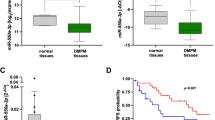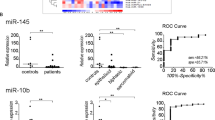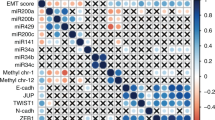Abstract
We identified a discrete number of microRNAs differentially expressed in benign or malignant mesothelial tissues. We focused on mir-145 whose levels were significantly downregulated in malignant mesothelial tissues and malignant pleural mesothelioma (MPM) cell lines as compared to benign tissues (pleura, peritoneum or cysts). We show that promoter hyper-methylation caused very low levels in MPM cell lines and specimens. Treatment of MPM cell lines with mir-145 agonists negatively modulated some protumorigenic properties of MPM cells, such as clonogenicity, cell migration and resistance to pemetrexed treatment. The main effector mechanism of the clonogenic death induced by mir-145 was that of accelerated senescence. We found that mir-145 targeted OCT4 via specific binding to its 3′-UTR. Increased intracellular levels of mir-145 decreased the levels of OCT4 and its target gene ZEB1, thereby counteracting the increase of OCT4 induced by pemetrexed treatment which is known to favor the development of chemoresistant cells. In line with this, reintroduction of OCT4 into mimic-145 treated cells counteracted the effects on clonogenicity and replicative senescence. This further supports the relevance of the mir-145-OCT4 interaction for the survival of MPM cells. The potential use of mir-145 expression levels to classify benign vs malignant mesothelial tissues and the differences between pemetrexed-induced senescence and that induced by the re-expression of mir-145 are discussed.
This is a preview of subscription content, access via your institution
Access options
Subscribe to this journal
Receive 50 print issues and online access
$259.00 per year
only $5.18 per issue
Buy this article
- Purchase on Springer Link
- Instant access to full article PDF
Prices may be subject to local taxes which are calculated during checkout






Similar content being viewed by others
References
Kaufman AJ, Pass HI . Current concepts in malignant pleural mesothelioma. Expert Review Anticancer Ther 2008; 8: 293–303.
Carbone M, Ly BH, Dodson RF, Pagano I, Morris PT, Dogan UA et al. Malignant mesothelioma: facts, myths, and hypotheses. J Cell Physio 2012; 227: 44–58.
Hazarika M, White RM Jr., Booth BP, Wang YC, Ham DY, Liang CY et al. Pemetrexed in malignant pleural mesothelioma. Clin Cancer Res 2005; 11: 982–992.
Mujoomdar AA, Tilleman TR, Richards WG, Bueno R, Sugarbaker DJ . Prevalence of in vitro chemotherapeutic drug resistance in primary malignant pleural mesothelioma: result in a cohort of 203 resection specimens. J Thorac Cardiov Sur 2010; 140: 352–355.
Tang G, Tang X, Mendu V, Tang X, Jia X, Chen QJ et al. The art of microRNA: various strategies leading to gene silencing via an ancient pathway. Biochimica et biophysica acta 2008; 1779: 655–662.
Ji X . The mechanism of RNase III action: how dicer dices. Curr Top Microbiol 2008; 320: 99–116.
Deng S, Calin GA, Croce CM, Coukos G, Zhang L . Mechanisms of microRNA deregulation in human cancer. Cell Cycle 2008; 7: 2643–2646.
Calin GA, Garzon R, Cimmino A, Fabbri M, Croce CM . MicroRNAs and leukemias: how strong is the connection? Leukemia Res 2006; 30: 653–655.
Calin GA, Croce CM . MicroRNA signatures in human cancers. Nat Rev Cancer 2006; 6: 857–866.
Pass HI, Goparaju C, Ivanov S, Donington J, Carbone M, Hoshen M et al. hsa-miR-29c* is linked to the prognosis of malignant pleural mesothelioma. Cancer Res 2010; 70: 1916–1924.
Pignot G, Cizeron-Clairac G, Vacher S, Susini A, Tozlu S, Vieillefond A et al. microRNA expression profile in a large series of bladder tumors: identification of a 3-miRNA signature associated with aggressiveness of muscle-invasive bladder cancer. Int J Cancer 2013; 132: 2479–2491.
Adammek M, Greve B, Kassens N, Schneider C, Bruggemann K, Schuring AN et al. MicroRNA miR-145 inhibits proliferation, invasiveness, and stem cell phenotype of an in vitro endometriosis model by targeting multiple cytoskeletal elements and pluripotency factors. Fertil Steril 2013; 99: 1346–1355.
Wu Y, Liu S, Xin H, Jiang J, Younglai E, Sun S et al. Up-regulation of microRNA-145 promotes differentiation by repressing OCT4 in human endometrial adenocarcinoma cells. Cancer 2011; 117: 3989–3998.
Schaefer A, Jung M, Mollenkopf HJ, Wagner I, Stephan C, Jentzmik F et al. Diagnostic and prognostic implications of microRNA profiling in prostate carcinoma. Int J Cancer 2010; 126: 1166–1176.
Xu N, Papagiannakopoulos T, Pan G, Thomson JA, Kosik KS . MicroRNA-145 regulates OCT4, SOX2, and KLF4 and represses pluripotency in human embryonic stem cells. Cell 2009; 137: 647–658.
Kashyap V, Rezende NC, Scotland KB, Shaffer SM, Persson JL, Gudas LJ et al. Regulation of stem cell pluripotency and differentiation involves a mutual regulatory circuit of the NANOG, OCT4, and SOX2 pluripotency transcription factors with polycomb repressive complexes and stem cell microRNAs. Stem cells and development 2009; 18: 1093–1108.
Samardzija C, Quinn M, Findlay JK, Ahmed N . Attributes of Oct4 in stem cell biology: perspectives on cancer stem cells of the ovary. Journal of ovarian research 2012; 5: 37.
Kumar SM, Liu S, Lu H, Zhang H, Zhang PJ, Gimotty PA et al. Acquired cancer stem cell phenotypes through Oct4-mediated dedifferentiation. Oncogene 2012; 31: 4898–4911.
Tsai LL, Yu CC, Chang YC, Yu CH, Chou MY . Markedly increased Oct4 and Nanog expression correlates with cisplatin resistance in oral squamous cell carcinoma. J Oral Pathol Med 2011; 40: 621–628.
Linn DE, Yang X, Sun F, Xie Y, Chen H, Jiang R et al. A Role for OCT4 in Tumor Initiation of Drug-Resistant Prostate Cancer Cells. Genes & cancer 2010; 1: 908–916.
Du Z, Jia D, Liu S, Wang F, Li G, Zhang Y et al. Oct4 is expressed in human gliomas and promotes colony formation in glioma cells. Glia 2009; 57: 724–733.
Chiou SH, Wang ML, Chou YT, Chen CJ, Hong CF, Hsieh WJ et al. Coexpression of Oct4 and Nanog enhances malignancy in lung adenocarcinoma by inducing cancer stem cell-like properties and epithelial-mesenchymal transdifferentiation. Cancer Res 2010; 70: 10433–10444.
Dai X, Ge J, Wang X, Qian X, Zhang C, Li X . OCT4 regulates epithelial-mesenchymal transition and its knockdown inhibits colorectal cancer cell migration and invasion. Oncol Rep 2013; 29: 155–160.
Peng S, Maihle NJ, Huang Y . Pluripotency factors Lin28 and Oct4 identify a sub-population of stem cell-like cells in ovarian cancer. Oncogene 2010; 29: 2153–2159.
Rudd RM . Malignant mesothelioma. Brit Med Bull 2010; 93: 105–123.
Casarsa C, Bassani N, Ambrogi F, Zabucchi G, Boracchi P, Biganzoli E et al. Epithelial-to-mesenchymal transition, cell polarity and stemness-associated features in malignant pleural mesothelioma. Cancer Lett 2011; 302: 136–143.
Schramm A, Opitz I, Thies S, Seifert B, Moch H, Weder W et al. Prognostic significance of epithelial-mesenchymal transition in malignant pleural mesothelioma. European journal of cardio-thoracic surgery. official journal of the European Association for Cardio-thoracic Surgery 2010; 37: 566–572.
Freund A, Laberge RM, Demaria M, Campisi J . Lamin B1 loss is a senescence-associated biomarker. Mol Biol Cell 2012; 23: 2066–2075.
Narita M, Narita M, Krizhanovsky V, Nunez S, Chicas A, Hearn SA et al. A novel role for high-mobility group a proteins in cellular senescence and heterochromatin formation. Cell 2006; 126: 503–514.
Narita M, Nunez S, Heard E, Narita M, Lin AW, Hearn SA et al. Rb-mediated heterochromatin formation and silencing of E2F target genes during cellular senescence. Cell 2003; 113: 703–716.
Romanov VS, Pospelov VA, Pospelova TV . Cyclin-dependent kinase inhibitor p21(Waf1): contemporary view on its role in senescence and oncogenesis. Biochemistry Biokhimiia 2012; 77: 575–584.
Wajapeyee N, Deibler SK, Green MR . Genome-wide RNAi screening to identify regulators of oncogene-induced cellular senescence. Methods Mol Biol 2013; 965: 373–382.
Weinberg WC, Denning MF . P21Waf1 control of epithelial cell cycle and cell fate. Crit Rev Oral Biol Med 2002; 13: 453–464.
Kai K, D'Costa S, Yoon BI, Brody AR, Sills RC, Kim Y . Characterization of side population cells in human malignant mesothelioma cell lines. Lung Cancer 2010; 70: 146–151.
Canino C, Mori F, Cambria A, Diamantini A, Germoni S, Alessandrini G et al. SASP mediates chemoresistance and tumor-initiating-activity of mesothelioma cells. Oncogene 2012; 31: 3148–3163.
Yilmaz M, Christofori G . EMT, the cytoskeleton, and cancer cell invasion. Cancer Metast Rev 2009; 28: 15–33.
Warren L, Manos PD, Ahfeldt T, Loh YH, Li H, Lau F et al. Highly efficient reprogramming to pluripotency and directed differentiation of human cells with synthetic modified mRNA. Cell stem cell 2010; 7: 618–630.
Beltran AS, Rivenbark AG, Richardson BT, Yuan X, Quian H, Hunt JP et al. Generation of tumor-initiating cells by exogenous delivery of OCT4 transcription factor. Breast Cancer Res 2011; 13: R94.
Granville L, Laga AC, Allen TC, Dishop M, Roggli VL, Churg A et al. Review and update of uncommon primary pleural tumors: a practical approach to diagnosis. Arch Pathol Lab Med 2005; 129: 1428–1443.
Jean D, Daubriac J, Le Pimpec-Barthes F, Galateau-Salle F, Jaurand MC . Molecular changes in mesothelioma with an impact on prognosis and treatment. Arch Pathol Lab Med 2012; 136: 277–293.
Zhang J, Sun Q, Zhang Z, Ge S, Han ZG, Chen WT . Loss of microRNA-143/145 disturbs cellular growth and apoptosis of human epithelial cancers by impairing the MDM2-p53 feedback loop. Oncogene 2013; 32: 61–69.
Lu Y, Chopp M, Zheng X, Katakowski M, Buller B, Jiang F . MiR-145 reduces ADAM17 expression and inhibits in vitro migration and invasion of glioma cells. Oncology reports 2013; 29: 67–72.
Lee HK, Bier A, Cazacu S, Finniss S, Xiang C, Twito H et al. MicroRNA-145 Is Downregulated in Glial Tumors and Regulates Glioma Cell Migration by Targeting Connective Tissue Growth Factor. PloS One 2013; 8: e54652.
Speranza MC, Frattini V, Pisati F, Kapetis D, Porrati P, Eoli M et al. NEDD9, a novel target of miR-145, increases the invasiveness of glioblastoma. Oncotarget 2012; 3: 723–734.
Klinge CM, Radde BN, Imbert-Fernandez Y, Teng Y, Ivanova MM, Abner SM et al. Targeting the intracellular MUC1 C-terminal domain inhibits proliferation and estrogen receptor transcriptional activity in lung adenocarcinoma cells. Mol Cancer Ther 2011; 10: 2062–2071.
Zhang J, Guo H, Qian G, Ge S, Ji H, Hu X et al. MiR-145, a new regulator of the DNA fragmentation factor-45 (DFF45)-mediated apoptotic network. Mol Cancer 2010; 9: 211.
Chen Z, Zeng H, Guo Y, Liu P, Pan H, Deng A et al. miRNA-145 inhibits non-small cell lung cancer cell proliferation by targeting c-Myc. J Exp Clin Canc Res 2010; 29: 151.
Wang S, Bian C, Yang Z, Bo Y, Li J, Zeng L et al. miR-145 inhibits breast cancer cell growth through RTKN. Int J Oncol 2009; 34: 1461–1466.
Bonifacio LN, Jarstfer MB . MiRNA profile associated with replicative senescence, extended cell culture, and ectopic telomerase expression in human foreskin fibroblasts. PLoS One 2010; 5: pii:e12519.
Basu D, Reyes-Mugica M, Rebbaa A . Role of the beta catenin destruction complex in mediating chemotherapy-induced senescence-associated secretory phenotype. PLoS One 2012; 7: e52188.
Cahu J, Bustany S, Sola B . Senescence-associated secretory phenotype favors the emergence of cancer stem-like cells. Cell death & disease 2012; 3: e446.
Rodier F . Detection of the senescence-associated secretory phenotype (SASP). Methods Mol Biol 2013; 965: 165–173.
Kurashige J, Kamohara H, Watanabe M, Hiyoshi Y, Iwatsuki M, Tanaka Y et al. MicroRNA-200b regulates cell proliferation, invasion, and migration by directly targeting ZEB2 in gastric carcinoma. Ann Oncol 2012; 19 (Suppl 3): S656–S664.
Gregory PA, Bracken CP, Smith E, Bert AG, Wright JA, Roslan S et al. An autocrine TGF-beta/ZEB/miR-200 signaling network regulates establishment and maintenance of epithelial-mesenchymal transition. Mol Cell Biol 2011; 22: 1686–1698.
Gregory PA, Bracken CP, Bert AG, Goodall GJ . MicroRNAs as regulators of epithelial-mesenchymal transition. Cell Cycle 2008; 7: 3112–3118.
Ceppi P, Peter ME . MicroRNAs regulate both epithelial-to-mesenchymal transition and cancer stem cells. Oncogene 2014; 33: 269–278.
Nakanishi H, Taccioli C, Palatini J, Fernandez-Cymering C, Cui R, Kim T et al. Loss of miR-125b-1 contributes to head and neck cancer development by dysregulating TACSTD2 and MAPK pathway. Oncogene 2014; 33: 702–712.
Acknowledgements
We acknowledge INAIL (Italian Workers' Compensation Authority) for grant support (to GB).
Author information
Authors and Affiliations
Corresponding author
Ethics declarations
Competing interests
The authors declare no conflict of interest.
Additional information
Supplementary Information accompanies this paper on the Oncogene website
Rights and permissions
About this article
Cite this article
Cioce, M., Ganci, F., Canu, V. et al. Protumorigenic effects of mir-145 loss in malignant pleural mesothelioma. Oncogene 33, 5319–5331 (2014). https://doi.org/10.1038/onc.2013.476
Received:
Revised:
Accepted:
Published:
Issue Date:
DOI: https://doi.org/10.1038/onc.2013.476
Keywords
This article is cited by
-
Expression of microRNAs in leukocytes and serum of asbestosis patients
European Journal of Medical Research (2023)
-
Artichoke phytocomplex modulates serum microRNAs in patients exposed to asbestos: a first step of a phase II clinical trial
Journal of Experimental & Clinical Cancer Research (2022)
-
Biological basis for novel mesothelioma therapies
British Journal of Cancer (2021)
-
P53-regulated miR-320a targets PDL1 and is downregulated in malignant mesothelioma
Cell Death & Disease (2020)
-
Thymic Epithelial Tumors phenotype relies on miR-145-5p epigenetic regulation
Molecular Cancer (2017)



